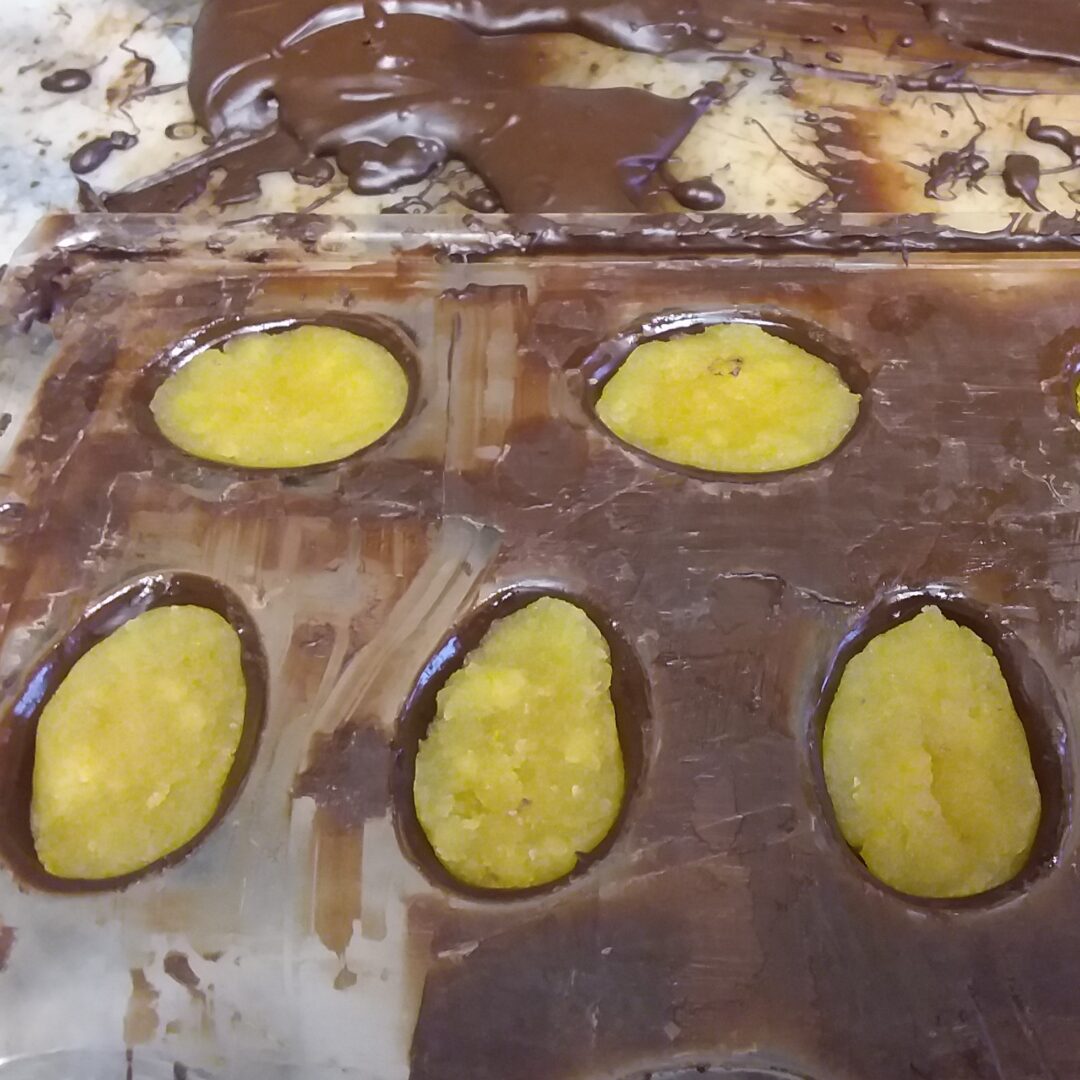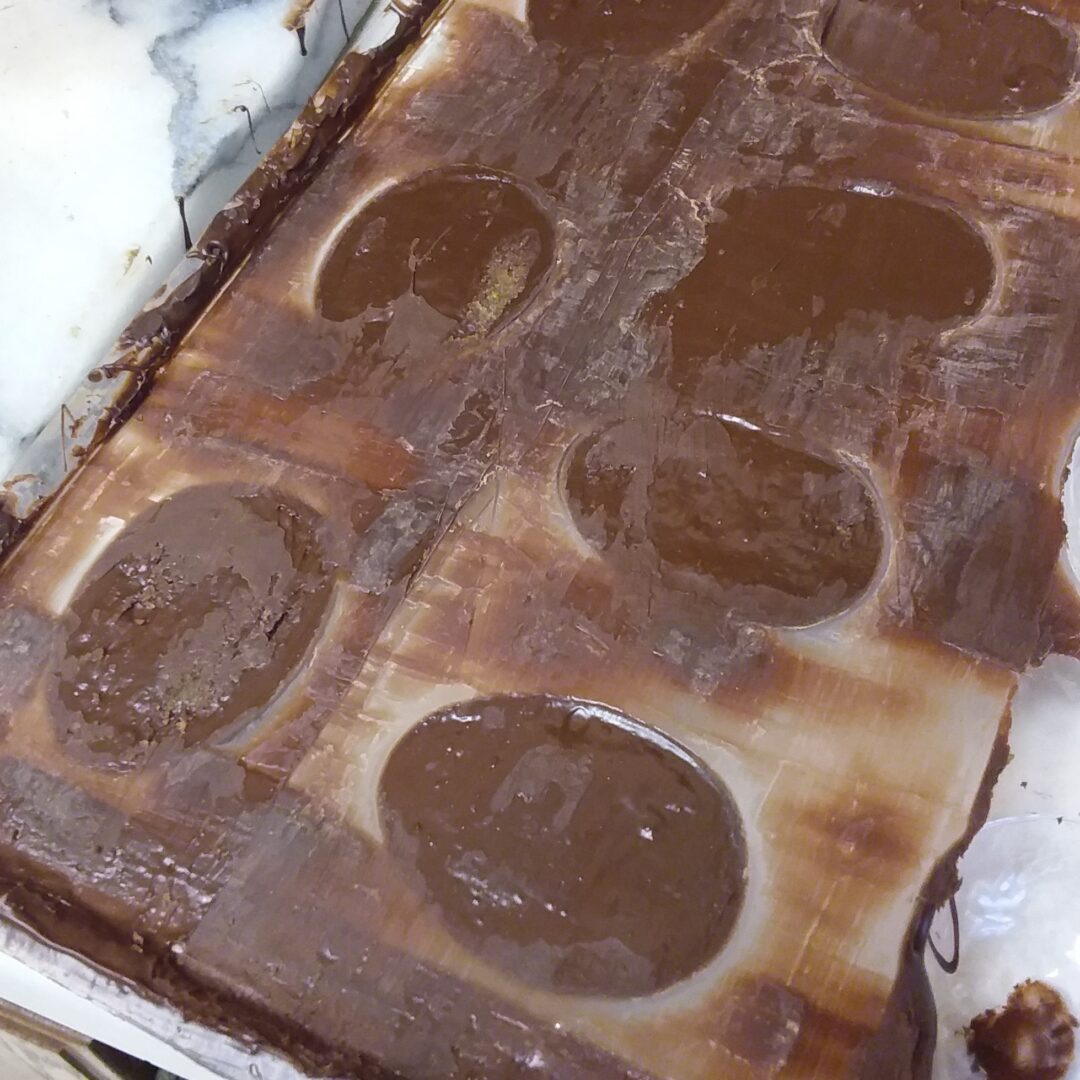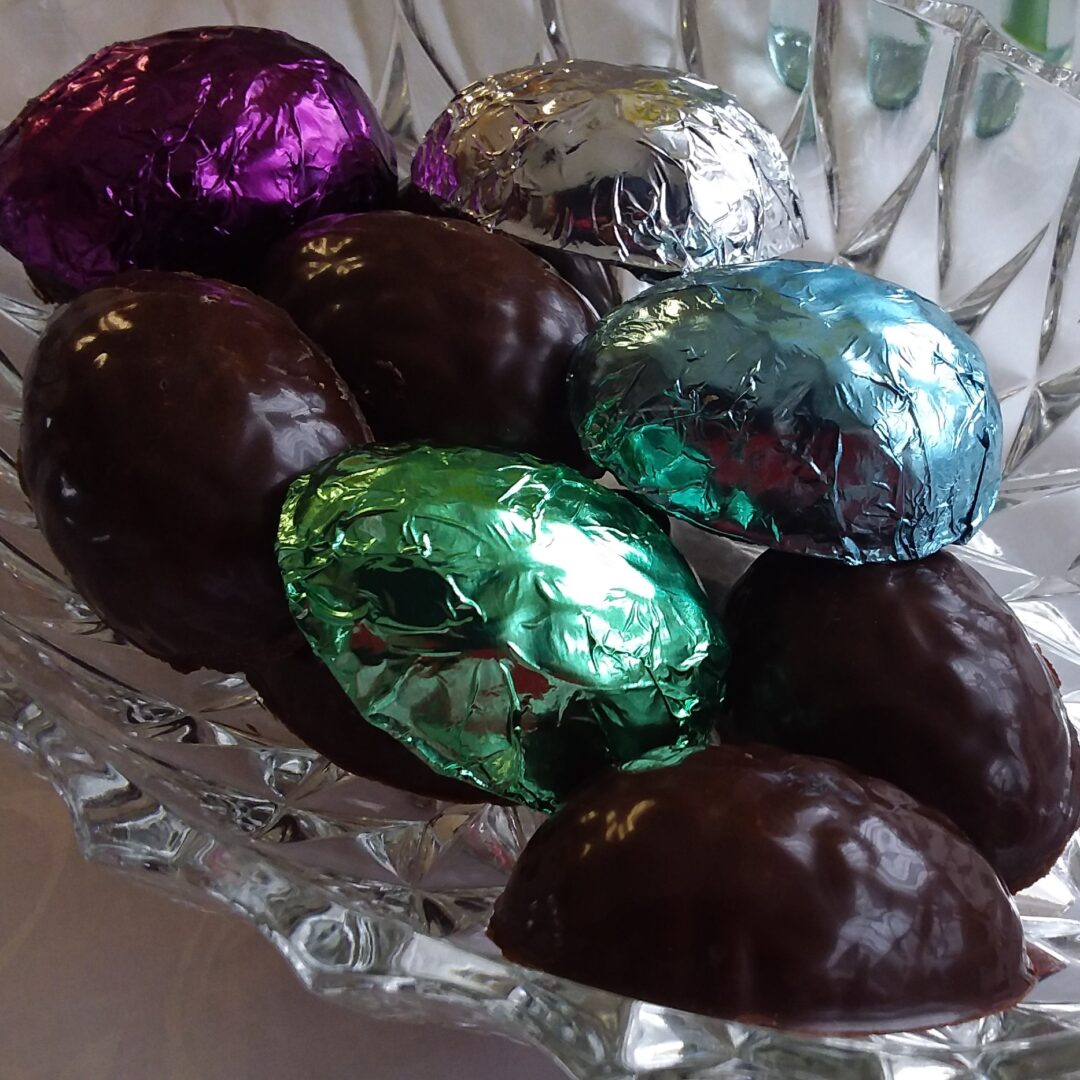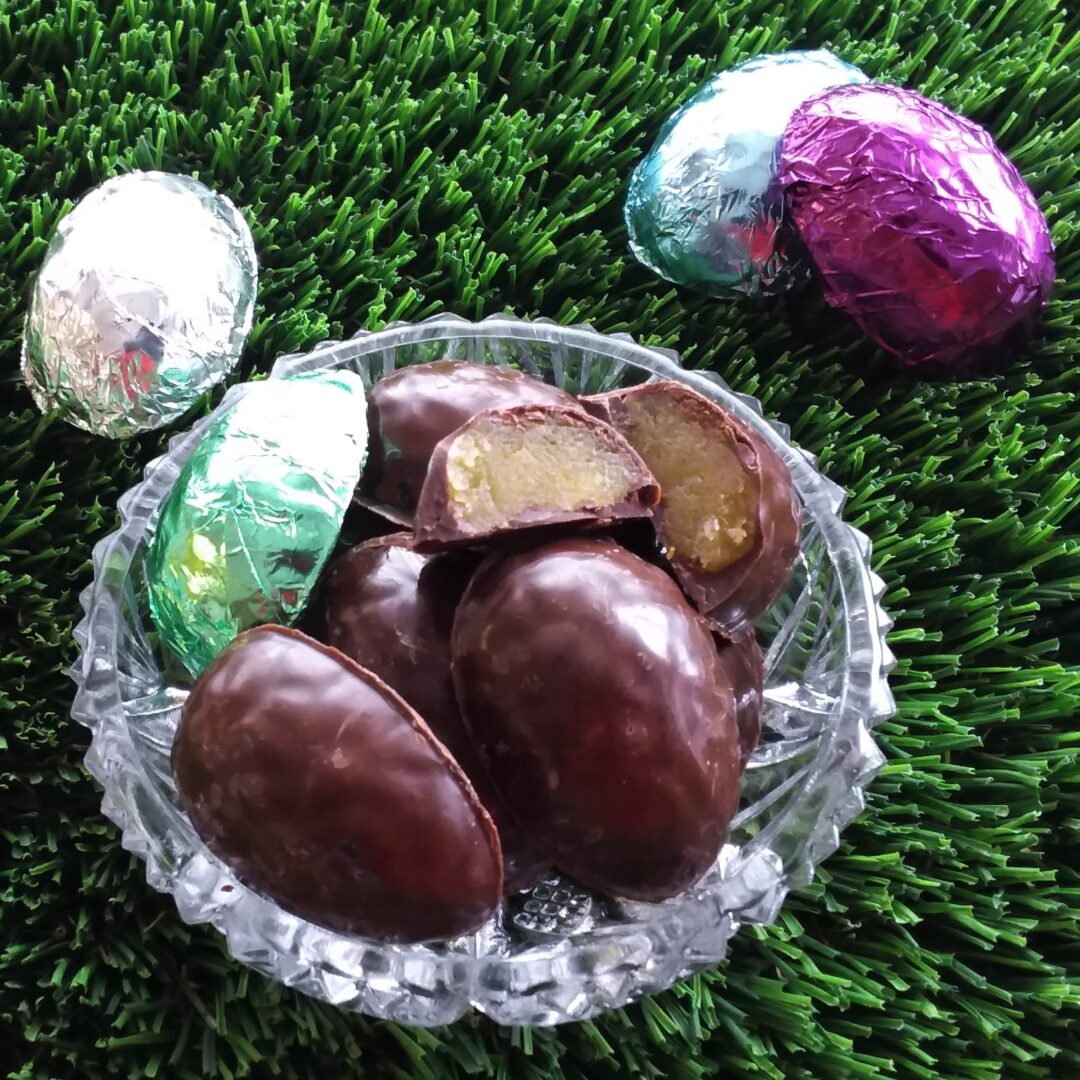These chocolates were inspired by an orange marzipan chocolate bar a friend of mine found by Niederegger. It is traditionally a less sweet marzipan option and was my step-mother’s preference.
While they were made in the form of Easter eggs, it is possible to use other mold forms of your choosing, especially during the rest of the year. The style of filling is a great way to begin making filled chocolates as there will be more control that other softer fillings.
I have shared a lot of information here. Please do not get overwhelmed. Chocolate making is can be very satisfying but there are steps to consider. Make the filling first and when you are happy with your tempering give these a go.
These chocolates were made with couverture, that is chocolate that contains cocoa butter. There is another option which is chocolate flavoured coating. It is made with palm oil and does not require tempering to mix the cocoa butter back into the chocolate mass. Use whichever you feel most comfortable with. This is supposed to fun not frustrating, especially when working with children.
p.s. Your spatula is your friend. It helps move the chocolate around while tempering and keeps molds as clean as needed for scraping flat bottoms.
1 cup almond flour
4 tsp. Cointreau
1 1/4 tsp. orange zest
6 Tbsp. icing sugar
1/4 bottle Dr. Oetker bitter almond essence
3 drops Dr. Oetker orange essence
1 Tbsp. orange juice (optional)
1/2 cup dark chocolate, melted
Stop. Close your eyes and take a deep breath. It is time to shift your focus away from everything that is going on in your day and be in the present moment with a new project. Breathe out. Put on an apron. It’s chocolate, you will need it. Wash your hands and let the nigglies of the day wash away with the warm water. “In my kitchen filled with care, I welcome Fire, Earth, Water, Air“. Begin.
Follow the steps for making traditional marzipan here. There is no egg white in this variation and the mixture will get drier more quickly than in the original version. For that reason double wrapping in plastic wrap and putting away in an airtight container is suggested. The marzipan was in my fridge for over a week before I was able to make the chocolates and adding the orange juice helped moisten the mixture, making into easier to manipulate the filling.
Bitter almond extract is explained in the marzipan post and is always my first choice as it is not as sweet other options. Dr. Oetker makes both the bitter almond and the orange essence and can be found in most European food stores.
If tempering chocolate couverture is a new skill, here is a step by step link to help . I highly recommend tempering a few times before attempting this project. Here are three simple options. Getting the tempering correct will allow people to touch and pickup your chocolates without the heat from fingers melting the chocolate. It will also ensure that the finished molded sweets will fall out of the mold properly, making the molds much easier to clean up afterwards.
There is enough marzipan to make 15 chocolates, depending on the size of the molds and the amount of nibbling beforehand. Not all the chocolate will be needed to make the shells but when the amounts are this small, the dark chocolate will harden very quickly so having extra is helpful. The leftover can be wrapped up and used on the next project.
Once the chocolate is tempered, transfer the chocolate to the molds, filling then so that all sides are covered. Tap the mold on the marble slab to remove extra air bubbles. This will ensure pretty decorative tops without blemishes. Turn the molds over and help the chocolate drip out by tapping upwards from under the mold. This will help the extra chocolate fall out before it gets to cold and hardens. This process is called raining as it looks like chocolate is raining onto your work surface. The intention is to leave a thin coat of chocolate on the mold and remove any chocolate not needed for that purpose. At this point the chocolate is sticking to the mold and there will be no air space between the two. Using a spatula, clean as much of the excess chocolate off the mold as possible. Ensure the chocolate at the edges of the molds are level with the mold. This will make for easier filling of the bottom of the mold once the shells are filled. The picture above shows well cleaned edges. Let the molds sit upside down on a tray or paper to harden. Do not fill until the chocolate has hardened.
Using a spatula, clean as much of the excess chocolate off the mold as possible. Ensure the chocolate at the edges of the molds are level with the mold. This will make for easier filling of the bottom of the mold once the shells are filled. The picture above shows well cleaned edges. Let the molds sit upside down on a tray or paper to harden. Do not fill until the chocolate has hardened.
One of the things that chocolate judges consider is the thickness of the outside shell. It is best when all the sides have a similar width so there are no surprises when the chocolate is bitten into. By keeping the mold upside down there is less likelihood that a thick top will be created as chocolate slides back down the sides of the mold before hardening.
Two or three minutes in the fridge can help the chocolate harden as well but do not forget the mold in the fridge or the shells may crack.
Roll a bit of marzipan in your hand and transfer to the hardened shell. Press the mixture into the mold, filling the shell, creating a smooth top and making sure none of the mixture is above the top of the mold. Add or remove as needed until the filling looks like the picture above.
By this time your extra chocolate will be hard and it will need melting and retempering. Once that is done transfer to the top and the chocolates and seal. Scrape off the excess chocolate with a spatula and let the chocolates harden.
This is where you will see any high points as the filling will show through once the chocolate is scraped away. If that happens, simply paint a little chocolate over the open section, let it harden and bare the experience in mind for next time. No one is going to complain about a little extra chocolate and most people will not even look at the bottom. As the chocolates cool, they will contract ever so slightly, breaking the vacuum with mold. The break is visible as the air space will be visible and a little cloudy. This will make it very simple to get the chocolates out. Simply turn the mold over, tap lightly and they should drop out.
As the chocolates cool, they will contract ever so slightly, breaking the vacuum with mold. The break is visible as the air space will be visible and a little cloudy. This will make it very simple to get the chocolates out. Simply turn the mold over, tap lightly and they should drop out.
 The chocolates will have darkened in colour.
The chocolates will have darkened in colour.
The less any chocolate is touched the better as it takes the shine away. Transfer to a storage container or serving dish. Easter eggs are one of the few chocolates that I wrap as it protects them and makes then easier to find during a children’s Easter egg hunt. Substitute extra orange juice for the Cointreau if you are making these for one. Cointreau & Almond Easter Eggs from My Kitchen Wand
Cointreau & Almond Easter Eggs from My Kitchen Wand


